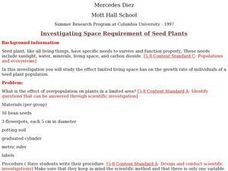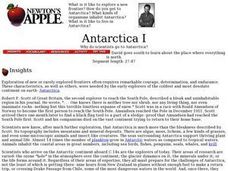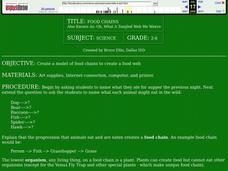Curated OER
Investigating Space Requirement of Seed Plants
Students use scientific methods to investigate the effects of overpopulation of seed plants on growth in a limited living space. Students relate seed plant population findings to that of other organisms.
Curated OER
The Basics of Creature Connectedness: Biodiversity Diversions
Learners study biodiversity. They participate in a scavenger hunt to look for presence of wildlife and connections in nature. They create a collage about Venezuelan biodiversity in small groups and present to the class. They write a...
Curated OER
Testing for Life
Students discuss food and the food groups and their organic nature. They test 3 different solutions and test for protein, starch and glucose. In addition, they create a master table on the board to collect all the teams results.
Curated OER
It's not just pretty - it's a survival method!
First graders write explanations for why certain animals can only live in certain environments. In this animal survival lesson plan, 1st graders take pictures of animals and place them into the right environment after a instructional...
Curated OER
Microarrays: Chipping Away at the Mysteries of Science and Medicine
High schoolers research microarrays on the internet in cooperative groups. Students write an essay describing the use of microarrays in environmental research and in medicine.
Curated OER
Learning From Leaves: Adaptations To Differing Light Levels
Students, in groups, examine plants with different light levels. They are given plants from a tropical and desert region. They write a hypothesis at the beginning of the experiment.
Curated OER
Ecosystems
Young scholars work in small groups to create a poster illustrating the flow of energy through a typical ecosystem, then present their posters to the class.
Curated OER
All About Trees
Second graders examine the artwork of Robert Harris and discuss how trees are an important part of their lives. In groups, they discover how people's use of the environment has changed over time and describe the climate and vegetation...
Curated OER
Classification of an Echinoderm
High schoolers study starfish through dissection. In this biology lesson plan, students explore the lives of starfish as they view a slide show, observe parts of echinoderms, and compare the classification of the starfish with other...
Curated OER
The Basics: Life Science
Students develop an understanding of the different fields of study that are encompassed by the term, life science. They view and discuss a video on the topic. In small groups they focus on on of the examples shown in the video to create...
Curated OER
Tree Lesson
Learners compare and contrast characteristics of conifer and hardwood trees. After collecting samples of branches around the school, they classify the branch as hardwood or conifer. Groups of students identify given twigs. They go...
Curated OER
Temperate Forests vs. Wetlands
Students compare and contrast the temperate forest and wetlands by researching them in groups. For this forest lesson plan, students identify the economic, ecological, and social benefits of each.
Curated OER
Antarctica I
Students explore exploring and expiditions then simlate their own on campus. They divide into small "expedition groups." Have each team report back to the class about their expeditions, using written, oral, or videotaped presentations.
Curated OER
Totem Poles -- Storytellers of Long Ago
Third graders discover the main purpose for totem poles was to communicate with others. In groups, they compare and contrast the four types of totem poles and the various symbols used. They write their own stories based off of pictures...
Curated OER
Science Talk about Mammals and Reptiles/Amphibians
Third graders use the internet to research mammals, reptiles and amphibians. They list important items about their chosen animal. Students identify characteristics of an animal and where they live. They classify animals as a mammal,...
Curated OER
Animal Adaptations
Tenth graders participate in an arthropod scavenger hunt. In groups of two, they identify and collect two specimens of arthropods in the school area, and create a table of all the specimens and what class they belong to.
Curated OER
DNA in a "Snap"
Students observe a model of DNA and answer probing questions like, "What does this model represent?" They then work in small groups to construct an accurate model of DNA per rubric provided and present to the class explaining their model...
Curated OER
Water Cycle Drama
Learners explore the water cycle. In groups, students choose a card and then pantomime the picture depicted on the card. Other group members guess the name of the cycle being performed. As a class, learners share the numerous ways each...
Curated OER
Making a Brassica Model
Young scholars apply skills they have learned to construct an accurate model of the Brassica and then work together on a group project. They analyze how the parts of a system go together, and how these parts depend on each other. ...
Curated OER
Tree Identification by the Use of Leaves
Students explore trees and their leaves. In this tree identification lesson plan, students observe items and are able to identify them by the five clues they are given. Once the leaves are identified, students in each group sketch the...
Curated OER
The Four Seasons
Students examine four paintings by Robert Harris and identify the season portrayed. Using the characteristics for each season, they write a poem and create a drawing of their own. In groups, they describe the different types of...
Curated OER
Growth and Changes in Plants
Students investigate the growth and changes in plants. They view a video and discuss the changes in plants. They work in small groups to demonstrate vocabulary words to the class. They visit a green house and take pictures of plants to...
Curated OER
The Human Body
Students research information about the human body. They read books and explore the Internet to gather information about the human body. Students create graphic representations and models of the body systems. Working in groups, they...

























